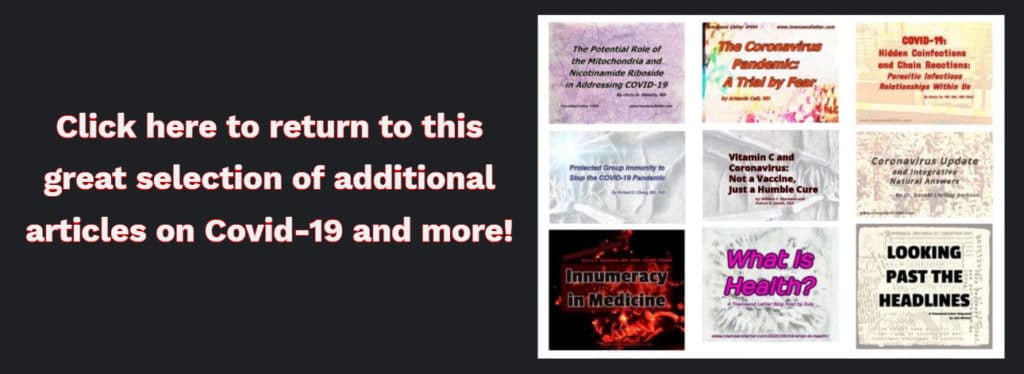…article continued…
While vitamin C is generally considered safe, there are certain ethnicities, such as those from African, Asian, and Mediterranean descent who may have G6PD deficiency that can be harmed with high doses of vitamin C. This hereditary X-linked disorder affects at least 329 million people globally. Even though most G6PD patients may be asymptomatic during their lifetime, it is important when treating the above-mentioned ethnicities that screening is done as to avoid any potential contraindication to the patient.19
The research on the safety and efficacy on various forms of vitamin C over the last 80 plus years is widely established. Currently, there are clinical trials and case studies taking place on megadose vitamin C as a single therapy or in conjunction with other therapies around the globe. Essentially, all of these studies are proving that megadose vitamin C is highly beneficial by enhancing the quality of life for the patient and mitigating the toxic effects of chemotherapy, shortening cold symptoms, and treating viruses with promising results. What the research is showing, even with COVID-19, is that vitamin C is a safe and effective treatment and is readily available to treat patients from COVID-19 to cancer.
- Anita Vazquez Tibau and Blanche D Grube
- Center for Environmental and Toxicological Research, University of Puerto Rico, Puerto Rico
- BD Grube is the Past President of the International Academy of Biological Dentistry & Medicine (IABDM), Pennsylvania
Complete References
- Aversa R, Petrescu RVV, Apicella A, et al. (2016) We are Addicted to Vitamins C and E-A Review. American Journal of Engineering and Applied Sciences.9(4):1003.1018
- Mayberry JA (2004) Scurvy and Vitamin C Food and Drug Law. [Accessed 2020] Available from https://dash.harvard.edu/bitstream/handle/1/8852139/Mayberry.html?sequence=2
- Albert Szent-Gyorgyi (2018) Science History Institute. [Accessed 2020] Available from https://www.sciencehistory.org/historical-profile/albert-szent-gyorgyi
- Linus Pauling, American Scientist. Encyclopaedia Britannica [Accessed 2020] https://www.britannica.com/biography/Linus-Pauling
- Cameron E, Pauling L, (1976) Supplemental ascorbate in the supportive treatment of cancer: Prolongation of survival times in terminal human cancer* (vitamin C).Proc. Natl. Acd. Sci. USA 73;10:3685-89 [Accessed 2020] https://www.pnas.org/content/pnas/73/10/3685.full.pdf
- Blaszczak W, Barczak W, Masternak J, et al. (2019) Vitamin C as a Modulator of the Response to Cancer Therapy. Molecules, 24(3), 435. [Accessed 2020] https://www.mdpi.com/1420-3049/24/3/453/htm
- Harris HR, Orsini N, Wolk A. (2014) Vitamin C and survival among women with breast cancer: A Meta-analysis. European Journal ofCancer.50;1223-1231 [Accessed 2020] http://www.healthlibrary.info/wp-content/uploads/2015/11/Vitamin-C-and-survival-among-women-with-breast-cancer.-A-meta-analysis.pdf
- Lv H, Wang C, Fang T, et al. (2018) Vitamin C preferentially kills cancer stem cells in hepatocellular carcinoma via SVCT-2. Npj Precision Oncology 2:1 [Accessed 2020] https://www.nature.com/articles/s41698-017-0044-8?elqTrackId=e3edacef089a471a8bef1b969cf94265
- Satheesh NJ, Samuel SM, Busselberg D, (2019) Combination Therapy with Vitamin C Could Eradicate Cancer Stem Cells. Biomlecules.10;79; doi:10.3390/biom10010079
- Jungeblut CW, (1935) Inactivation of Poliomyelitis Virus in Vitro by Crystalline Vitamin C (Ascorbic Acid). (From the Department ofBacteriology, College of Physicians and Surgeons, Columbia University, New York) J Exp Med 62(4):517-521[Accessed 2020] https://rupress.org/jem/article/62/4/517/4059/INACTIVATION-OF-POLIOMYELITIS-VIRUS-IN-VITRO-BY
- Gonzalez MJ, Berdie MJ, Miranda-Massari JR et al. (2016) High Dose Intravenous Vitamin C Treatment for Zika Fever. JOM 31:number 1[Accessed 2020] https://www.researchgate.net/profile/Michael_Gonzalez3/publication/309478186_High_Dose_Intravenous_Vitamin_C_Treatment_for_Zika_Fever/links/5823b75308aeb45b58896a35/High-Dose-Intravenous-Vitamin-C-Treatment-for-Zika-Fever.pdf
- Marcial-Vega V, Idxian Gonzalez-Terron G, Levy TE. (2015) Intravenous ascorbic acid and hydrogen peroxide in the management of patients with chikungunya. Bol Asoc Med P R. 107(1):20-4.
- Hemila H. (2003) Vitamin C and SARS coronavirus. J Antimicrob Chemother. 52(6): 1049–1050.
- Fowler III AA, Kim C, Lepler L, et al. (2017) Intravenous vitamin C as adjunctive therapy for enterovirus/rhinovirus induced acute respiratory distress syndrome. World J Crit Care Med. 6(1): 85–90.
- Cheng RZ. (2020) Can early and high intravenous dose of vitamin C prevent and treat coronavirus disease 2019 (COVID-19)? Medicine in Drug Discovery https://doi.org/10.1016/j.medidd.2020.100028
- Boretti A, Banik BK (2020) Intravenous vitamin C for reduction ofcytokines storm in acute respiratory distress syndrome. PharmaNutrition 12: 100190.
- Cantley L, Yun J, (2020) Intravenous High-Dose Vitamin C in Cancer Therapy [Accessed 2020] https://www.cancer.gov/research/key-initiatives/ras/ras-central/blog/2020/yun-cantley-vitamin-c
- Padayatty SJ, Riordan HD, Hewitt SM, et al. (2006) Intravenously administered vitamin C as cancer therapy: three cases. CMAJ v. 174(7): 937-942
- Quinn J, Gerber B, Fouche R, et al. (2017) Effect of High-Dose Vitamin C Infusion in a Glucose-6-Phosphate Dehydrogenase-Deficient Patient. Case Rep Med. 2017:5202606






